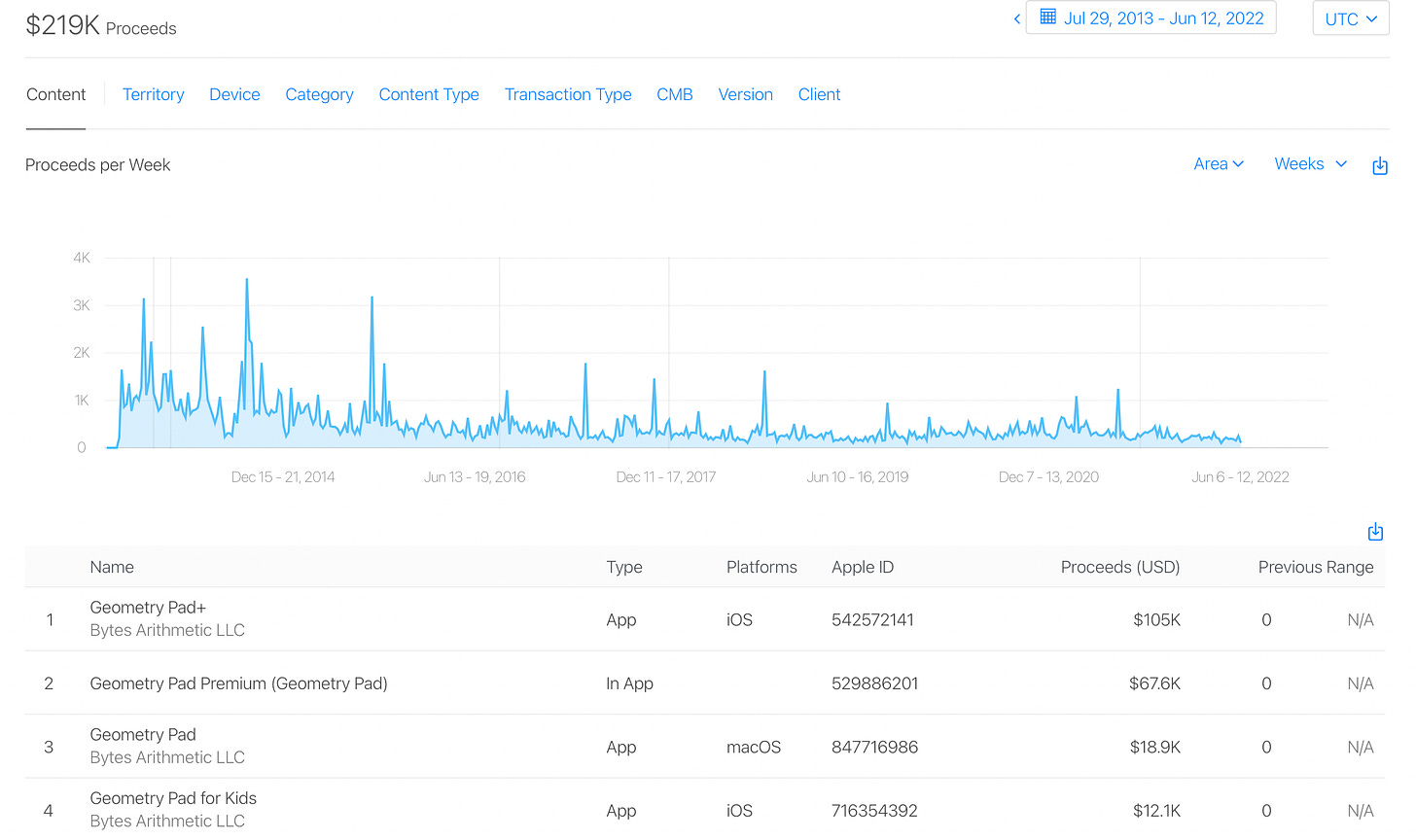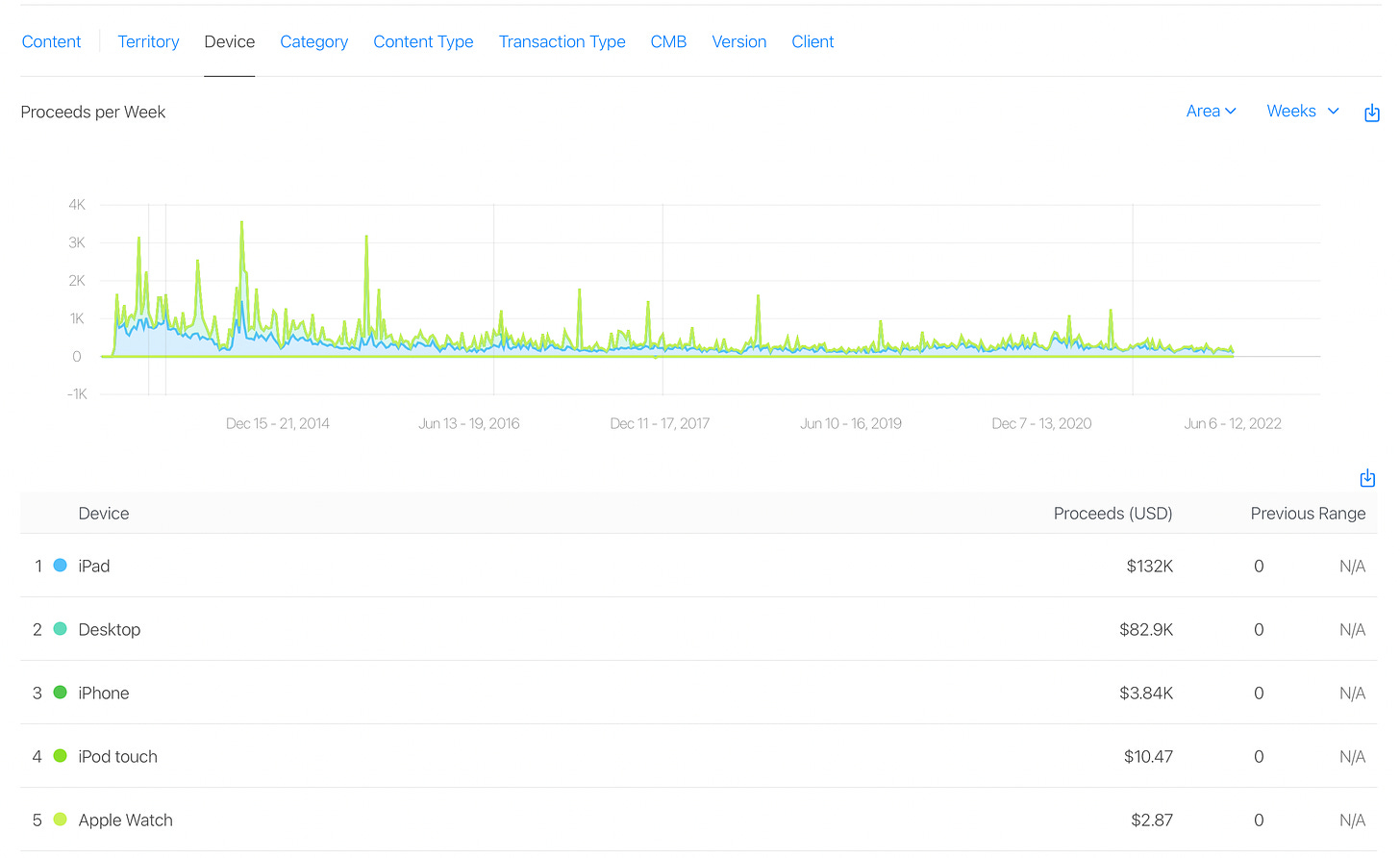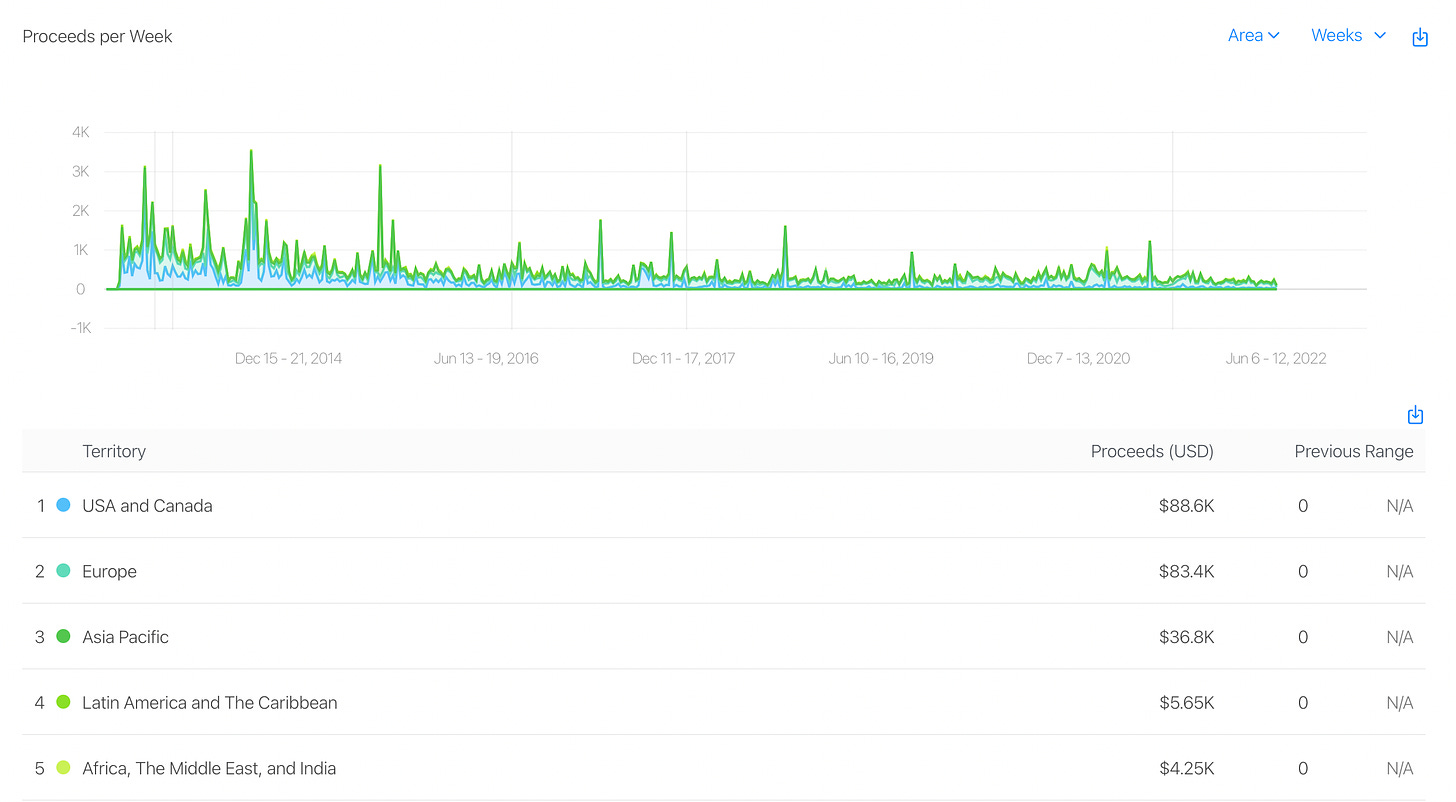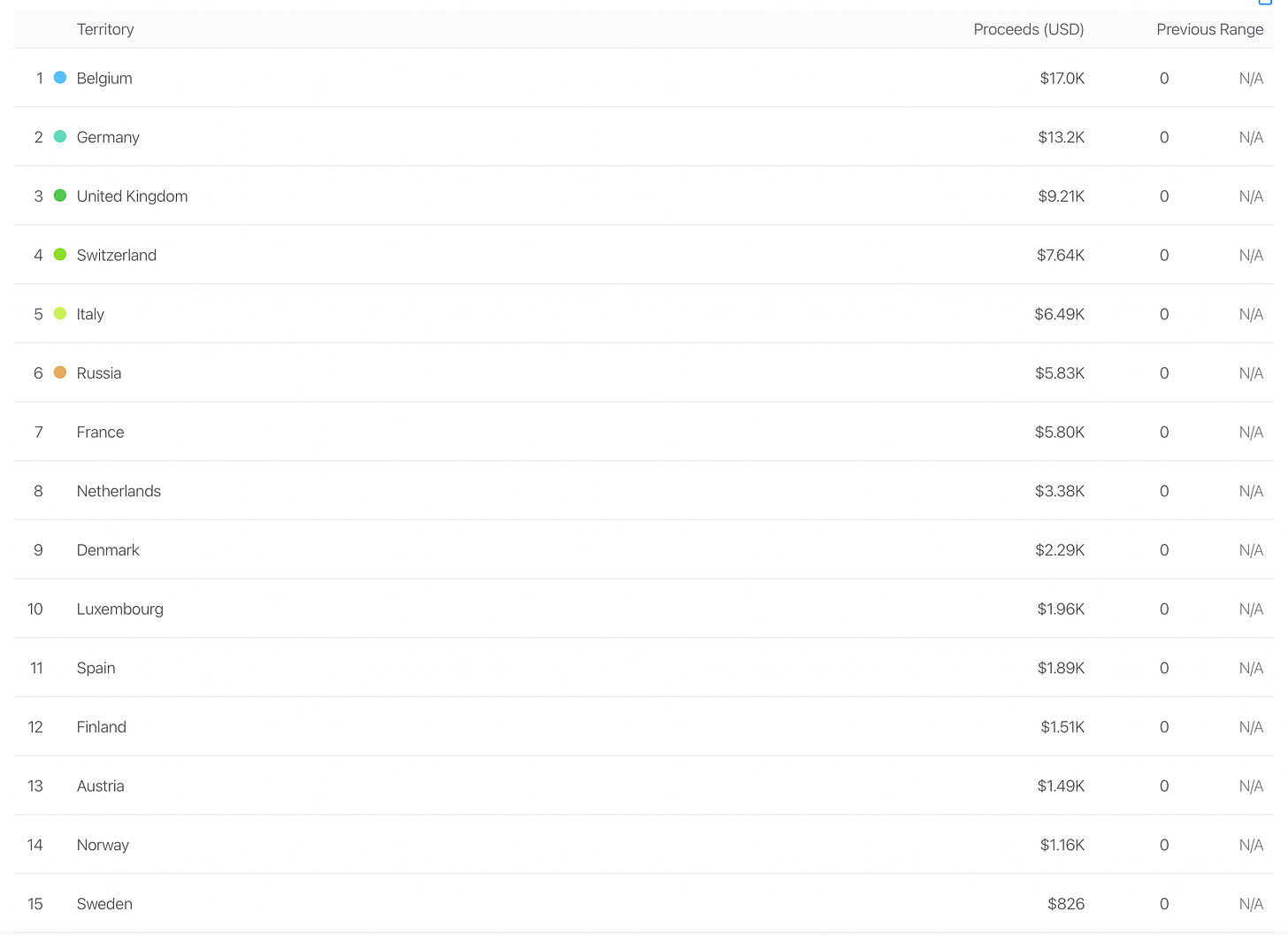Intro
This post summarizes 10 years of building and selling Geometry Pad - a plane geometry study companion app for iPad, macOS and Android tablets. I will share the history behind the app, some takeaways and lessons from building and selling it, and the revenue numbers so far. Finally, I will share my plans for what is coming next.
Disclaimer
Geometry Pad has been always a hobby and a side project that I build outside of working hours. I have changed multiple jobs since starting the project, currently a software engineer at Google (Geometry Pad is not affiliated with Google, and Google did not sponsor or otherwise endorsed this post).
Idea
It all started with a purchase of the first generation iPad back in 2010. I already had an iPhone but the screen size felt too limiting for content consumption and creation. I had a laptop for my main computing device at home. And even though it was technically portable, I could only get comfortable at a desk.
iPad held a promise of combining the two of my most favorite things: a book and a computer. Once I had my hands on it, I also realized it would be a great tool for drawing. Lacking any kind of artistic talents, I figured that plane geometry drawing app is the next best thing I could do. Geometry was also one of my favorite subjects back in high school.
First Version
Build & Launch
I had been building mobile apps for my full time job since 2010. So I was lucky to have early exposure to the mobile market, developer tools, and the process of publishing on the App Store.
Back in the days, Adobe AIR was one of the few the tools for building cross-platform mobile applications. I chose it to build Geometry Pad due to familiarity and simplicity of using ActionScript compared to Apple’s Objective C. Despite the drawbacks of the Adobe tools and its eventual demise, I think it was the right decision at the time. It would have taken a lot longer to onboard with a new language + framework and ship the first version of the app. I did end up porting Geometry Pad to Xamarin (C# + .NET Framework) later on, but that is a different story.
It took me about 8 months of working evenings and weekends to build the first version of Geometry Pad. I launched it on AppStore 10 years ago - in April 2012. The app’s functionality was very basic, but it felt sufficient for the first version. I couldn’t yet justify charging money for it, so the first version was free. I remember feeling incredibly excited to publish something of my own, and ship a working product.
Timing the Market
Another way I got lucky is with timing the market. iPad and AppStore were still new, but consumer demand for applications was already there. The market already had some very strong desktop software options such as Geogebra and Geometer’s Sketchpad. However, existing applications needed to be ported or rebuilt to run on the new Apple hardware. So the field was welcoming for the newcomers.
In general, my sense is that there was a lot less money and interest in building consumer software a decade ago. The past decade’s low interest rates funneled VC capital into software companies, heating up the competition across the board. And even though the barrier of entry today is as low as ever, gaining a market share is lot harder than it used to be.
Initial Feedback
Despite the drawbacks, bugs, and limited utility, the initial feedback I received was overwhelmingly positive. Until this day, I am very grateful to the first Geometry Pad users who discovered the app and spent their time to reach out with feedback. I received many great suggestions for improvements and new features, and it was very satisfying to communicate with users, learn about their needs, and work together on improving the app. Most of the updates that I published since then are based on the users’ feedback and requests.
Monetization
In-app Product
Encouraged by the initial feedback, I started working on monetization soon after launch. I decided to keep the application free and sell advanced features as an in-app purchase. The approach proved to be lucrative in the beginning. Download numbers remained strong, and my early conversion rate was close to the standard 1%.
Geometry Pad+
Unfortunately, the in-app approach became insufficient once Apple introduced volume purchase for educational institutions. Volume purchase is an opt-in and it allows schools to buy 20+ more copies of a mobile app with a 50% discount. It should come as no surprise that it was the preferred way for schools to buy iPad applications. Another catch is that volume purchase only works for paid applications, but not for in-app products. This is how Geometry Pad+ was born - out of necessity. Geometry Pad+ is a paid version of Geometry Pad that has all of the advanced features included. There is no other difference between the two.
Despite my reservations about keeping two nearly identical apps on the App Store, it paid off financially. School purchases constitute the bulk of the Geometry Pad+ income until this day.
Geometry Pad for Kids
Eventually, AppStore introduced stringent requirements for mobile apps in the Kids category. The most important limitation is the requirement of a parental gate in front of anything that children should not be able to access. That includes opening Web links such as Geometry Pad FAQ page, or sending feedback emails.
I felt like the restrictions would be damaging to the user experience if implemented in Geometry Pad or Geometry Pad+. At the same time, Geometry Pad seemed like a good fit for the Kids category. Same as with Geometry Pad+, I didn’t see any other option except for building a dedicated Geometry Pad for Kids.
Many parents did choose Geometry Pad for Kids over other options, so I don’t regret the decision. However, it did convolute the offering even further and made the process of building and shipping more complicated as well.
Evolution
The decade of Geometry Pad had its ups and downs. The first few years were the most eventful and lucrative:
Hundreds of insightful conversations with teachers and geometry enthusiasts.
Adding many more advanced features - all based on the user feedback.
Building and releasing Geometry Pad for Android tablets and Macs.
Getting featured on the AppStore front-page and receiving Editor’s Choice award.
Volume purchase program had become the single most lucrative sales channel.
As the time passed, Geometry Pad started loosing the advantage:
The responsibility for losing the market share is mostly on me. I had slowed the pace of development significantly due to combination of factors: health issues, energy draining full time jobs, lack of vision for further development, developing other interests, and just plain complacency.
The market leaders (Geogebra) eventually caught up and built a strong mobile offering. This is not an extinction level event (see more on that in the final chapter), but it does change the calculus.
Many smaller direct competitors emerged, including some (not all) that copied Geometry Pad.
I have put a significant effort into building apps tangential or complimentary to Geometry Pad, but without notable success to report.
AppStore now has very solid applications in each vertical where I had some users in the past: architectural design, floor planning software, vector graphics, scientific calculators.
Eventually, Geometry Pad revenue flatlined. That is not to say it went down to zero - the tail of the revenue turned out to be quite long.
Downloads
Perhaps the most impressive (and misleading) number is the number of downloads of the free version of Geometry Pad: 2.6 million.
As you will see below, this did not equate to a life changing financial windfall. Many of the peaks on the chart above are what I call “volume” downloads. Most likely originating from a school district, working on iPad deployments.
Proceeds
Before sharing the revenue number, I’d like to note that my overall expenses were fairly low (I don’t have an aggregate number though):
Hardware: three generations of MacBook Pro
Graphic design: icons and promotional artwork
Localization
Web hosting
AppStore developer fee
Some modest experiments with ads
Lifetime
The lifetime proceeds (excluding AppStore commission) come at $219,000.
This it not at all an impressive number for a software engineer in the US when converted to an hourly rate (10 years == 520 weeks == 20800 hours == $10.53 / hour), but I am still grateful. The calculation is of course not entirely fair. The actual number of hours I put in is an order of magnitude lower.
There are 16 apps on that list, however Geometry Pad apps account for 95% of the total.
Device Breakdown
As you can see from the figure above, Geometry Pad+ accounts for nearly half of the proceeds. Out of that, over 80% of the purchases are coming from Desktop. It is hard to tell definitively that all of them are school volume purchases. But based on some non-aggregated data I attribute no less than 50% to school purchases.
Territory Breakdown
Overall
Europe (top 15)
Asia Pacific (top 10)
Takeaways
Below is the list of takeaways from my experience with building and selling educational apps. Many of them sound obvious in retrospect, but are still good to emphasize.
First-mover advantage is important. Especially in a new, fast growing market.
Use familiar tools if you can to ship faster and maximize the advantage.
Niche applications (e.g. educational) may still attract significant interest from the users.
User feedback is extremely valuable. Take as much as you can get and act on it.
Monetize early to capture the product momentum and set the expectations with the users.
Enroll into the volume purchase program to get more deals with schools.
North American market is important but don’t underestimate the rest of the world. Localize early and sell globally.
The long revenue tail requires only minimal maintenance work assuming some initial traction.
What’s Next
I’ve been long struggling with the long term goals and strategy for Geometry Pad. The recent example of Geogebra (acquired by BYJU’S for $100,000,000) was an inspiration and a reminder that educational software is in demand.
Today, I will attempt to set the goal and the strategy for the product to give it another life.
Goal
Sell 1,000,000 units of Geometry Pad.
The goal has the following benefits from my perspective
Ambitious. Considering the current numbers and the trend.
Simple. Just one round number.
Measurable. This is very important. I realize that a monetary goal is not that great for a side project from some perspective. However, it is one of the few that are easy to measure. Delivering value to the user and personal fulfillment is something that I care about as well. But it is hard to measure objectively.
Achievable. There are millions of iPads in schools and millions of students using them. Selling 1 million copies does not seem out of reach.
Strategy
I realize that Geometry Pad is far from perfect, and I only have so much time I can dedicate towards improving it. However, I think I can do more to build on Geometry Pad strengths and win over some users:
Keep Geometry Pad easy to use. This is one of the things users praise when they choose Geometry Pad over Geogebra.
Tailor Geometry Pad to each platform (iOS, Android, macOS). It does take more effort to maintain a native app for each platform. However, I believe it creates a better user experience and makes the app to stand out.
Deep platform integrations. A web app is significantly harder to integrate with the feature unique to each platform. Geometry Pad already has advantage by using many native APIs. For example: importing images from the photo library, drawing on maps, integrating with the iOS file system.
Fixed costs. It is tempting to build features such as cloud storage for documents, online community, live collaboration, etc. However, most such features introduce a significant overhead in resources and therefore the costs. I believe the product is better off if I rely on external integrations as much as possible.
Fixed price for the lifetime of the project. Geometry Pad has just one person working on it, without venture capital backing. That means I can deliver a lot of value to the users over time, for a fixed cost, and still achieve the product goals.
Last but not least: publish this newsletter with updates on progress towards the goal. I am thinking to share weekly revenues, and anything else related to Geometry Pad.








